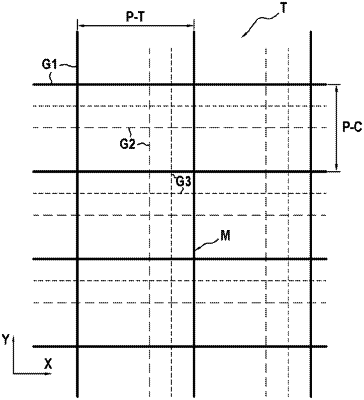| CPC B26D 5/005 (2013.01) [D06H 7/00 (2013.01); B26D 2005/002 (2013.01)] | 9 Claims |

|
1. A method for automatic cutting of defective parts in a fabric with a pattern repeating at a certain pitch, referred to as the pattern pitch, comprising the steps of:
producing a theoretical layout of parts to be cut on a theoretical representation of the fabric whilst respecting layout constraints associated with the parts, in which a reference point and a layout constraint on the fabric are associated with each part to be cut, the layout constraint being chosen from an absolute constraint, a relative constraint, a relative symmetry constraint, and a free constraint;
spreading out at least one layer of fabric on a cutting table;
ascertaining actual features of at least one portion of the spread-out fabric modifying the theoretical layout in order to generate an actual layout of parts on the spread-out fabric, taking into account the actual features of the fabric;
identifying, in the actual layout, defective parts which will contain defects once cut in the fabric and which will need to be cut again; and
automatically allocating each defective part to a new theoretical layout by adjusting the layout constraints associated with the defective parts according to the actual layout;
wherein the defective part is:
a part which, after generating the actual layout, is positioned on a defect of the spread-out fabric; or
a part which, after generating the actual layout, overlaps another part of the layout; or
a part which, after generating the actual layout, is positioned on an area of the spread-out fabric which has a large deformation; or
a part which, after generating the actual layout, cannot be entirely cut in the spread-out fabric; or
a part which, after generating the actual layout and after cutting, has a cutting defect; or
a part which, after generating the actual layout, has a geometric defect; or
a daughter part with which a relative constraint or a relative symmetry constraint with respect to a defective mother part requiring to be cut again is associated; and
wherein the layout constraint on the fabric associated with each part to be cut is chosen from:
a) the absolute constraint being for which the position of the reference point of the part with respect to the pattern is determined so that the pattern appears in a desired position of the part;
b) the relative constraint being for which the position of the reference point of the part, referred to as the daughter part, is determined with respect to a connection point of another part, referred to as a mother part, so that the position of the reference point of the daughter part with respect to the pattern is the same as the position of the connection point of the mother part;
c) the relative symmetry constraint being for which the position of the reference point of the part, referred to as the daughter part, is determined with respect to a connection point of another part, called the mother part, so that the position of the reference point of the daughter part with respect to the pattern is symmetric with respect to the pattern of the position of the connection point of the mother part; and
d) the free constraint being for which the position of the reference point of the part with respect to the pattern is free.
|